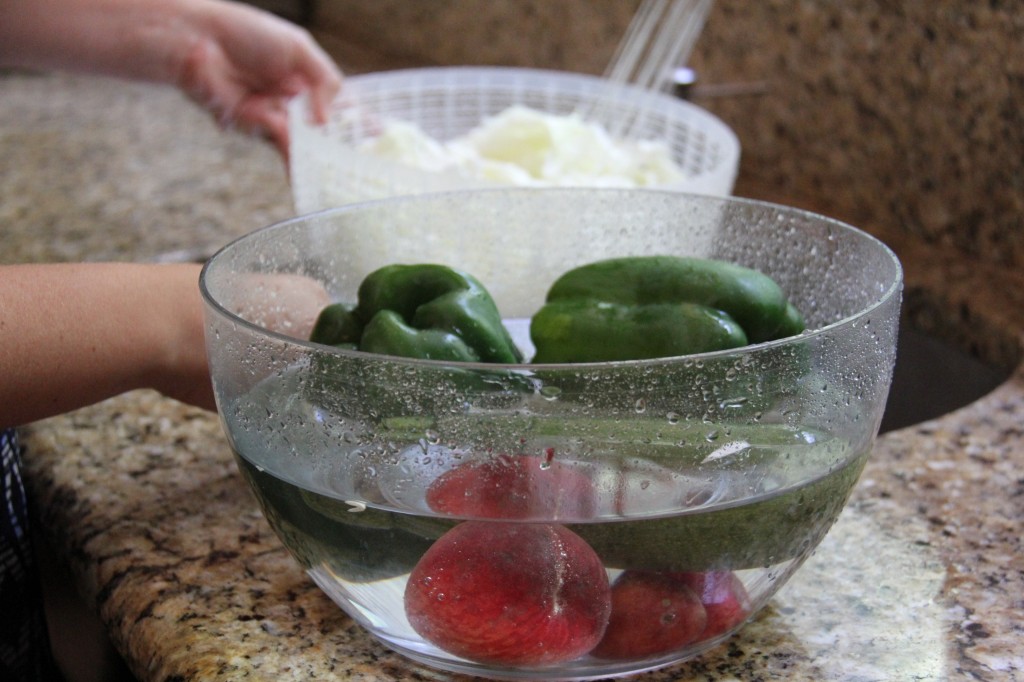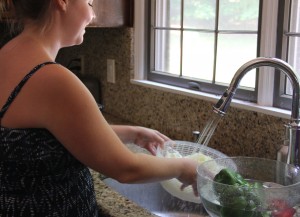
Have you ever heard of “The Dirty Dozen” and why washing your produce is so important? Well let me fill you in:
Yesterday, I had some friends over for a play date and tea. During our chitchat, the topic of how to clean veggies came up and I felt inspired to write this little ditty about the dirty dozen and to share with you how I clean my produce. It’s so important to take the time to clean your fruits and veggies, here’s why:
Every year the Environmental working group releases a shopper’s guide to pesticides. Apples top its annual “Dirty Dozen” list of fruits and vegetables with the highest pesticide residue for the third year in a row.
Check out the “Dirty Dozen:”
- Apples
- Strawberries
- Grapes
- Celery
- Peaches
- Spinach
- Sweet
- Bell peppers
- Nectarines (imported)
- Cucumbers
- Potatoes
- Cherry tomatoes
- Hot peppers
Among the worst offenders are apples, strawberries and grapes. Things my kids eat all the time!
Additionally, the EWG added a “plus” category for the second year, noting two items—domestically-grown summer squash, plus kale and collards—that, though they didn’t meet Dirty Dozen standards, were commonly contaminated with extremely toxic pesticides. These “organophosphates”, dangerous to the nervous system, were phased out of agricultural use in the 1970s and ’80s, but still linger in many farm fields.
There is, however, good news. There is a “Clean fifteen.” These offer hope to those of us that cannot always afford organic. Many of the safest foods have naturally protective coating, like onions and papayas.
Check out the “Clean Fifteen:”
- Corn
- Onions
- Pineapple
- Avocados
- Cabbage
- Sweet peas (frozen, since they’re more readily available)
- Papayas
- Mangoes
- Asparagus
- Eggplant
- Kiwi
- Grapefruit
- Cantaloupe
- Sweet potatoes
- Mushrooms
I wonder why potatoes are contaminated while sweet potatoes are not?
The good news? According to the EWG, “The health benefits of a diet rich in fruits and vegetables outweigh the risks of pesticide exposure.”
Besides pesticides, there can be many different kinds of bacteria on your produce. Remember, your watermelon goes on the same conveyor belt as your raw chicken. If you don’t wash the watermelon, the chicken goop can sit on it, seeping under the rind and into the part that you eat.
So how should you clean your produce? My doctor’s office told me that washing with water should do the trick but, 5 years ago, Andrea at the health food store introduced me to the following way to clean produce. Here is how I recommend cleaning your veggies:
- Wash your hands and counter with soap and water.
- In a bowl, make a solution of: 1- cup water with 1- cup regular distilled vinegar and 1 tbs. baking soda (a sizzle happens when it’s added. It’s fun for the kids to watch). Add grape seed extract, 20 drops and mix.
- Put it into a clean spray bottle ( I also use this to clean my countertops)
- Put veggies in a bowl, fill with water and add some veggie spray (3-4 squirts)
- Soak for 2-3 minutes
- Rinse under running water and store.
Washing fresh produce is one of the best ways to minimize exposure to pesticides and food born illnesses. It only takes an extra couple of minutes to protect your health, so remember to wash up!

